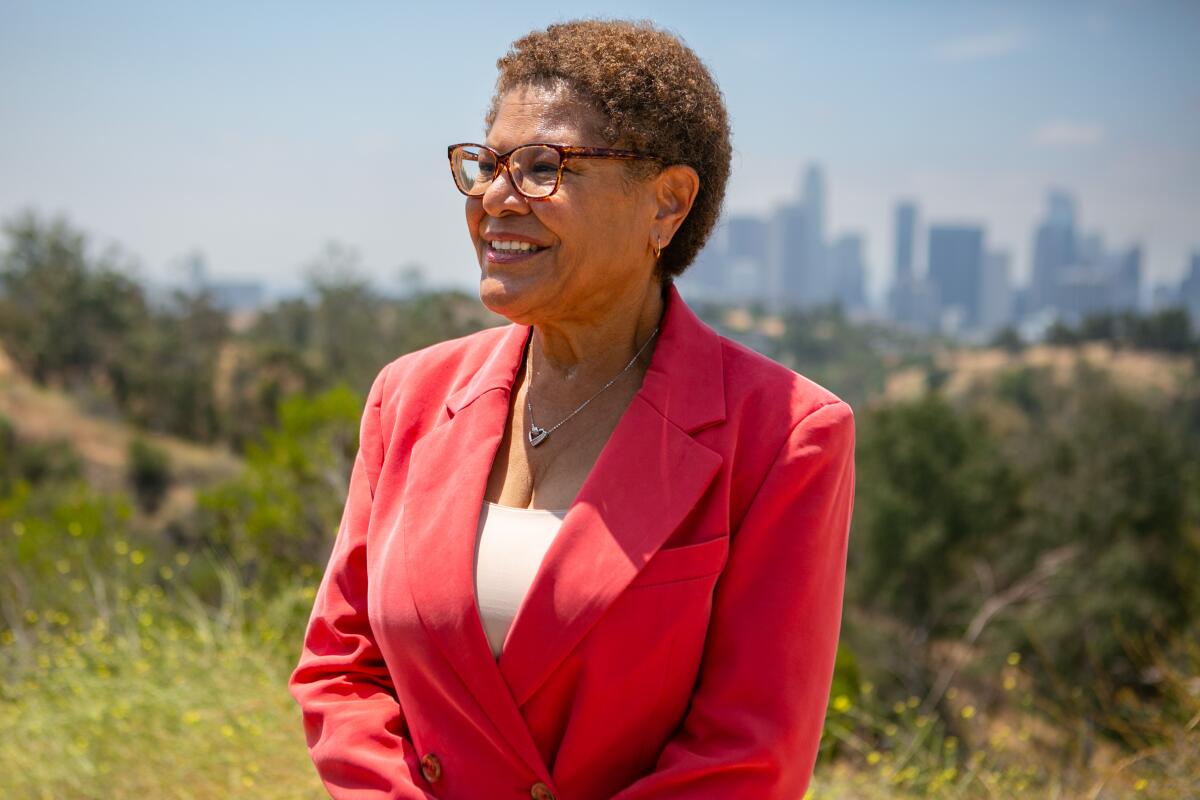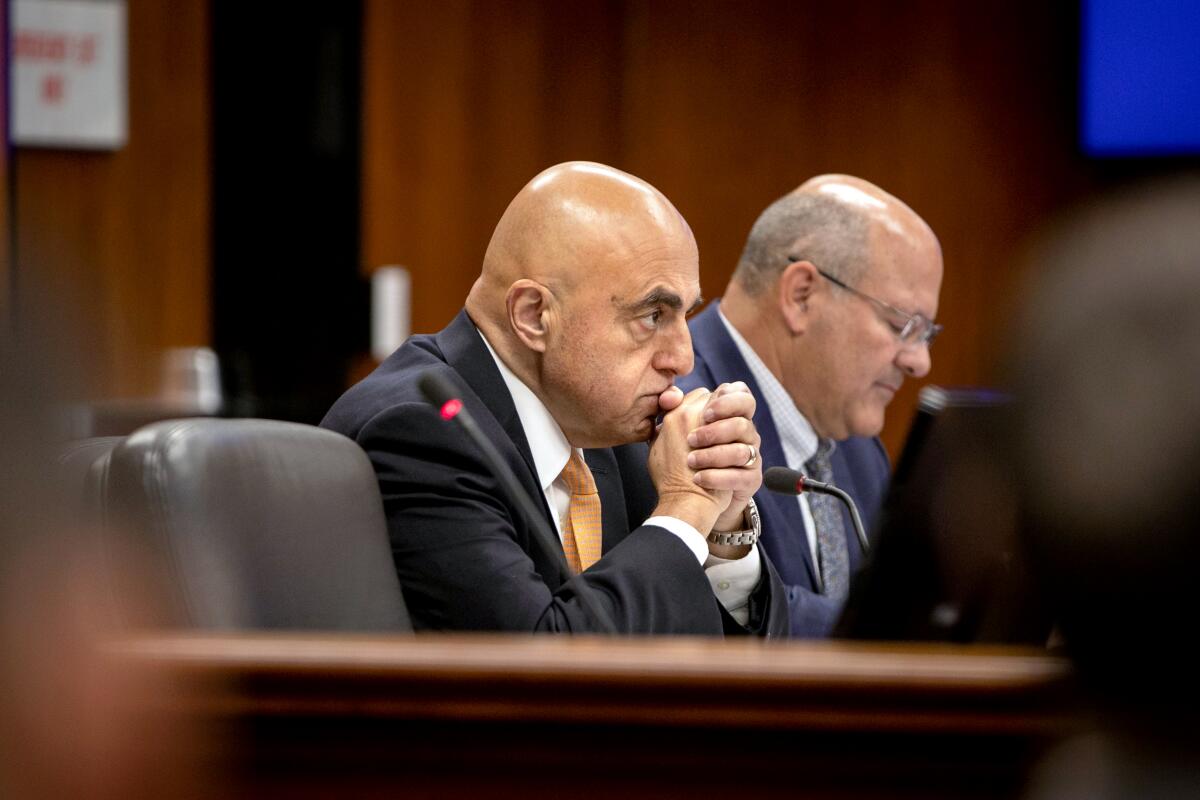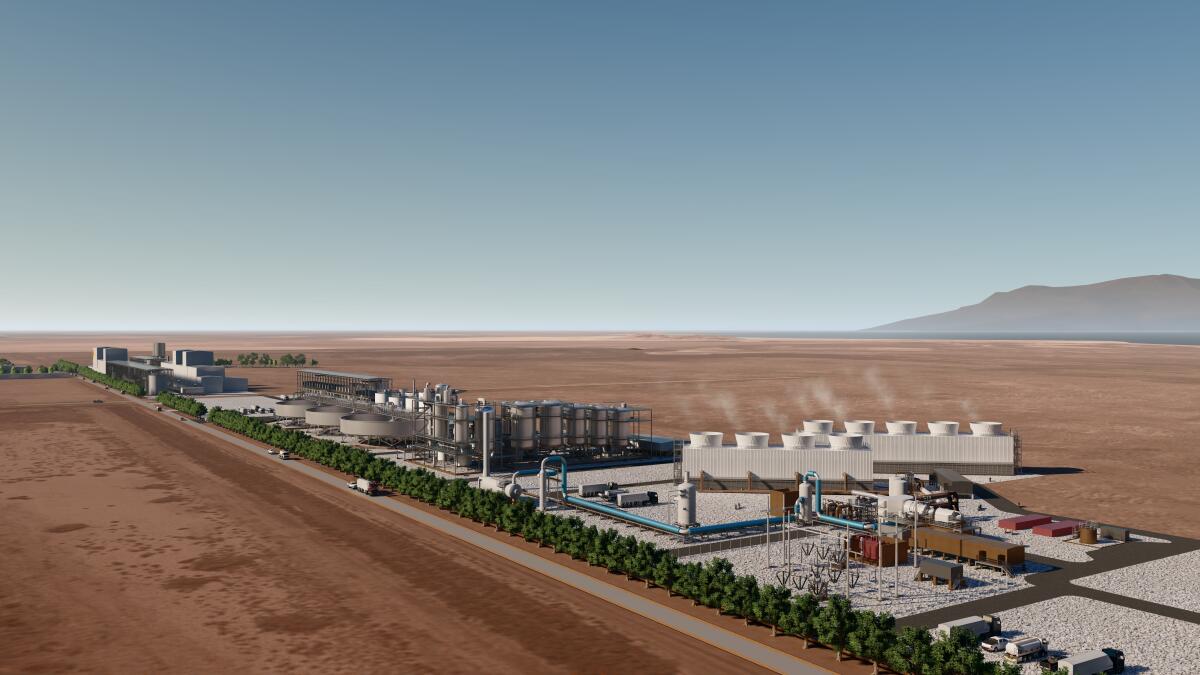Column: Karen Bass faces a big climate test as she chooses the DWP’s next leader

- Share via
Los Angeles Mayor Karen Bass has just over a month to choose the city’s next clean-energy leader.
With the L.A. Department of Water and Power’s current general manager, Marty Adams, set to retire March 1, Bass is mulling her options. And a coalition of climate advocacy and environmental justice groups want to know who those options are.
In a letter addressed to Bass, 15 groups — including the California Environmental Justice Alliance, Heal the Bay and the Sierra Club — are urging the city to “publicly release a list of its top candidates, the metrics by which they were chosen, and ultimately the factors that were considered in choosing the future nominated general manager.”
“For the sake of transparency and public accountability, we ask that this process be open and fair,” the groups wrote.
You're reading Boiling Point
Sammy Roth gets you up to speed on climate change, energy and the environment. Sign up to get it in your inbox twice a week.
You may occasionally receive promotional content from the Los Angeles Times.
The DWP’s next general manager will play a huge role in determining whether Los Angeles achieves its goal of 100% climate-friendly energy by 2035 — an ambitious target set by the previous mayor, Eric Garcetti. Bass’ office told me last month that she continues to support the 2035 goal, even as climate has been less of a public focus for her than it was for her predecessor.
The water and power agency’s next leader will probably face competing demands from the International Brotherhood of Electrical Workers Local 18, the union that represents thousands of DWP workers. IBEW members staff the DWP’s gas-fired power plants and have fought to keep them open, even as they add to the climate crisis and pollute the air in surrounding neighborhoods.
The DWP’s new general manager “also needs to have demonstrated the temperament and track record of ethical conduct critical to leading an organization that has been plagued with scandal,” the environmental groups wrote.
Indeed, it’s fair to say the agency has been “plagued with scandal.”
The general manager before Adams, David Wright, was sentenced to six years in prison after he pleaded guilty to bribery, one of several city officials implicated in a federal corruption probe. And earlier this month, the DWP’s board president, Cynthia McClain-Hill, stepped down after The Times reported on ethical concerns. (McClain-Hill maintains that her actions were proper.)
As a result, the DWP is very much in the public eye — and not just for ethics and energy reasons. The agency’s next leader will also be responsible for reducing L.A.’s reliance on the Colorado River and other water sources drying up with global warming.
So will Bass do as the environmental groups have asked, and publicly name the general manager candidates?
Doesn’t sound like it. When I asked the mayor’s office for comment, I got a written response attributed to spokesperson Gabby Maarse, which read: “We have engaged with stakeholders and advocates throughout this process thanks to a longer timeline and a national search firm and the Mayor is happy to meet with groups involved with this letter.”

One possible candidate is Aram Benyamin, the DWP’s chief operating officer. Rick Cole, the city’s chief deputy controller, told me he’d bet on Benyamin for the general manager’s job, calling him a “safe choice” because he already works for the DWP.
“He’s a known quantity. Outsiders have often encountered what the medical field calls ‘organ rejection,’” Cole said in an email.
Benyamin declined to talk with me, referring me to the DWP’s communications office. In a written statement, the agency told me the public has had opportunities to weigh in on the general manager search process, including at DWP board meetings.
Whoever ends up running the agency, I don’t envy them. Balancing the competing demands of organized labor, the City Council, the mayor’s office and other political and economic forces — not to mention the overriding need to provide ever-cleaner energy and ever-scarcer water at affordable prices, all while the world continues to heat up — is a gargantuan undertaking.
But if Los Angeles can’t figure it out, with all our money and ingenuity, I have trouble imagining anyone else will.
On that note, here’s what’s happening around the West:
TOP STORIES

It’s not just California — new research shows how much groundwater levels are falling in agricultural regions around the world. “There are far more cases where things are getting worse than there are cases where things are getting better,” one of the researchers told my L.A. Times colleague Ian James. And it’s not just farmers looking to tap into underground aquifers. The Times’ Michael Hiltzik has a fascinating column on efforts by Cadiz Inc. to rebrand its controversial Mojave Desert groundwater project — which would sell water to Southern California cities — as good for environmental justice, because it could help supply low-income communities of color that currently don’t have enough clean drinking water.
“This is called climate change. It is real, it is happening.” That’s what San Diego Mayor Todd Gloria said last week after intense rains and floods devastated his city, forcing families to evacuate their homes in chest-deep water and turning roads into rivers, as my colleague Grace Toohey reports. Gloria is right: Increasingly intense swings between wet and dry are what scientists have told us to expect in California as the world gets warmer. Toohey and Hayley Smith wrote more about this phenomenon here, explaining that El Niño, climate change and seasonal patterns have made “thousand-year-storms” more likely than ever.
More people died in car crashes than were murdered in Los Angeles last year. That’s according to The Times’ Rachel Uranga and Libor Jany, who report that 336 people died in car crashes in 2023, more than half of them pedestrians. To me, this story is a reminder that as much harm as automobiles do via their tailpipe pollution — to our planet’s climate and to the air we breathe — they’re plenty deadly on their own. Speaking of which, a new bill from state Sen. Scott Wiener (D-San Francisco) would require newly sold cars to have speed-governing devices — or at least annoying buzzers that go off when you drive 10 mph over the speed limit. Details here from my colleague Noah Goldberg.
THE ENERGY TRANSITION
America’s biggest-ever solar-plus-storage project just came online in the Mojave Desert, in California’s Kern County. The project will send electricity all over the state, with Starbucks buying a chunk of the power, Canary Media’s Eric Wesoff reports. In other good news for climate-friendly energy, Utility Dive’s Diana DiGangi writes that Northern California’s Humboldt County just received a $427-million federal grant to help fund construction of offshore wind turbines. (Looking for more positive vibes? Check out my conversation on climate solutions with Rabbi Morris Panitz at L.A.’s Ikar synagogue this past Saturday.)
The Dixie fire was California’s second-largest wildfire on record, and the first to burn from one side of the Sierra Nevada to the other. Now Pacific Gas & Electric will be penalized $45 million over its role in igniting the blaze, as decreed by the California Public Utilities Commission, The Times’ Hayley Smith reports. (Although two commissioners dissented, with one of them suggesting the $45-million penalty might not be enough, per the Sacramento Bee’s Ishani Desai.) In Oregon, meanwhile, a jury issued an $85-million wildfire verdict against electric utility PacifiCorp. The Warren Buffett-owned company is expected to be on the hook for billions in fire damages, the Associated Press reports.
Why has California done so little to ensure that electric vehicle chargers actually work? My colleague Russ Mitchell took a look, explaining that state officials “chose not to require that charger companies meet performance standards as it doled out $1 billion in subsidies, grants and other assistance to charger companies, with billions more on the way.” The pattern continued last week, with members of the California Air Resources Board blasting Volkswagen’s maintenance of its EV charging stations before approving the company’s $200-million plan anyway, as Mitchell reports. In another transportation decision facing criticism, Politico reports that a different California agency just approved $200 million for new lanes on the 15 Freeway.
POLITICAL CLIMATE

Los Angeles County is drafting a policy that would require apartment owners to install air conditioning or otherwise help renters stay cool during heat waves. The exact temperature requirement is still being determined, The Times’ Rebecca Ellis and Hayley Smith report. This is exactly the kind of program we’ll need more of as the planet heats up. We could also use more efforts to keep wildfire smoke out of our homes — including nursing homes. There’s a growing problem with fire smoke harming the air quality in long-term care facilities, Kylie Mohr reports for KFF Health News.
The Biden administration has paused the approval process for 17 natural gas export terminals, so that officials can study how much climate damage they would do. As far as climate activists are concerned, there’s no question President Biden should reject the projects, the Associated Press’ Matthew Daly reports. One of the projects in question is a Gulf Coast gas export terminal expansion backed by Sempra Energy, parent firm of San Diego Gas & Electric, per the San Diego Union-Tribune’s Rob Nikolewski.
Climate change is on the ballot in the Golden State — including in the March 5 primary election. Brooke Staggs has a great roundup for Southern California News Group on the many important decisions we’re being asked to make, including deciding the fate of a law that would ban new oil and gas extraction within 3,200 feet of homes, schools and hospitals. In related news, Politico reports that at a U.S. Senate debate, two of California’s three leading Democratic candidates questioned the feasibility of banning the sale of new gasoline-fueled cars by 2035, one of Gov. Gavin Newsom’s highest-impact climate policies.
AROUND THE WEST
Huge housing developments are going up in wildfire zones across Southern California, where it’s cheaper and easier to build homes than in many coastal cities, whose residents often fight to block new apartment buildings. The Desert Sun’s Erin Rode and Grist’s Jake Bittle have a great in-depth story exploring the risks of building new homes in wildfire zones — and the forces prompting developers to do so anyway. They focus on Riverside County, which, they write, is growing fast “as new housing developments pop up in the foothills to absorb the region’s growing population pushed out from more expensive coastal areas.”
Turns out the nanoplastics in water bottles aren’t even the worst part — the tiny plastic particles often have dangerous chemicals attached to them. “Some of these chemical additives have been tied to maladies such as breast and prostate cancer, heart disease and diabetes, as well as problems with children’s brain development and adult fertility,” as my colleague Susanne Rust writes. Rust also reports that microplastic particles sitting on piles of fertilizer are getting blown into the air.
Forget about the Oscars and Golden Globes — let’s geek out over the lesser-known EMA Awards. The Environmental Media Assn. has been giving out these climate-focused awards for 33 years, NPR’s Chloe Veltman reports, recognizing movies and TV shows that feature environmental storylines and also honoring productions that practice sustainability behind the scenes. This year’s ceremony was held on Saturday; the Hollywood Reporter’s Kirsten Chuba wrote about the winners, which included Disney’s “Avatar: The Water of Water” and the Apple TV+ series “Extrapolations” (which I wrote about last year).
ONE MORE THING

After I wrote glowingly last week about a lithium extraction and geothermal power plant just starting construction in California’s Imperial Valley, one of the most common questions I got from readers was this: Won’t the facility use a lot of water?
The short answer: Yes, it will. But let’s not lose sight of the larger context.
As journalism students at Arizona State University’s Cronkite School reported last week in an excellent investigation, dozens of lithium mines proposed across the American West could use large amounts of water in a region already grappling with climate-fueled shortages. The two leading lithium and geothermal projects in the Imperial Valley — including the one I just wrote about — could collectively use roughly 3 billion gallons of water a year from the shrinking Colorado River.
Three billion gallons sounds like a lot — and it is. Sort of.
Imperial’s thirsty farm barons sucked up 787 billion gallons of Colorado River water last year, more than anyone else in the West. And what if those farmers have to give up a little water so we can have lithium for our electric cars and climate-friendly geothermal power to keep the lights on after sundown? The farmers might not love it, but it sounds like a worthwhile trade to me.
I also noted last week that Imperial County environmental justice group Comite Civico del Valle was concerned about the lithium and geothermal plant starting construction. Sure enough, Comite Civico now says it will sue the county, citing “potential pollution from construction equipment and diesel trucks to and from the site, unaddressed earthquake risks and inadequate long-term monitoring of hazardous waste, dust and other potential health hazards,” as the Desert Sun’s Janet Wilson writes.
I hesitate to dismiss those concerns entirely. But having covered a lot of renewable energy projects across the western U.S., from solar and wind farms to long-distance power lines, I can say with pretty good certainty that the potential harms from this one are relatively minor. Even Comite Civico’s leader says he’d ultimately like to see the project move forward.
I’ve said it before, and I’ll say it again: There’s no such thing as a perfect climate change solution. And there’s no way to solve the climate crisis without accepting some collateral damage. For more on that theme, stay tuned for Thursday’s newsletter.
This column is the latest edition of Boiling Point, an email newsletter about climate change and the environment in California and the American West. You can sign up for Boiling Point here. And for more climate and environment news, follow @Sammy_Roth on X.
Toward a more sustainable California
Get Boiling Point, our newsletter exploring climate change, energy and the environment, and become part of the conversation — and the solution.
You may occasionally receive promotional content from the Los Angeles Times.






